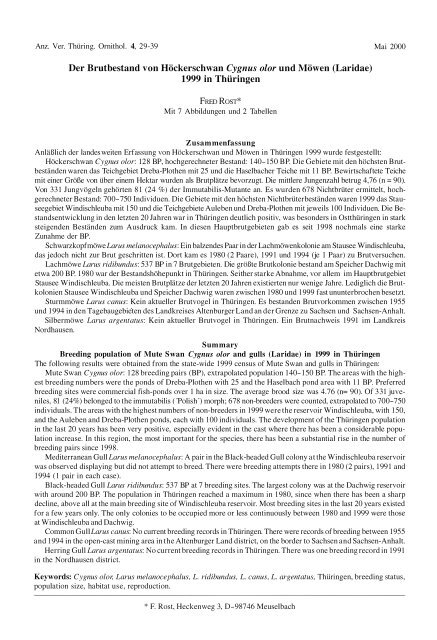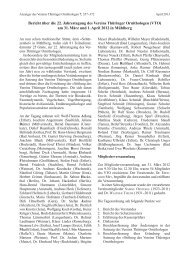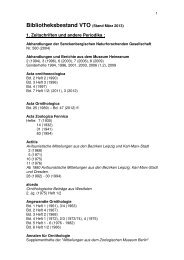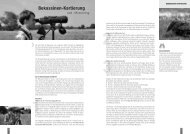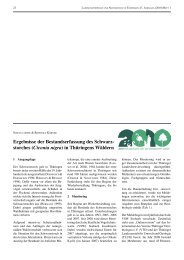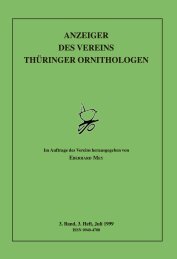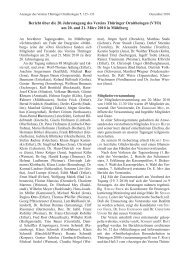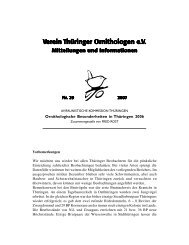anzeiger des vereins thüringer ornithologen - Verein Thüringer ...
anzeiger des vereins thüringer ornithologen - Verein Thüringer ...
anzeiger des vereins thüringer ornithologen - Verein Thüringer ...
Sie wollen auch ein ePaper? Erhöhen Sie die Reichweite Ihrer Titel.
YUMPU macht aus Druck-PDFs automatisch weboptimierte ePaper, die Google liebt.
Anz. Ver. Thüring. Ornithol. 4, 29-39<br />
Der Brutbestand von Höckerschwan Cygnus olor und Möwen (Laridae)<br />
1999 in Thüringen<br />
FREO RoST*<br />
Mit 7 Abbildungen und 2 Tabellen<br />
Mai 2000<br />
Zusammenfassung<br />
Anläßlich der lan<strong>des</strong> weiten Erfassung von Höckerschwan und Möwen in Thüringen 1999 wurde festgestellt:<br />
Höckerschwan Cygnus olor: 128 BP, hochgerechneter Bestand: 140- 150 BP. Die Gebiete mit den höchsten Brutbeständen<br />
waren das Teichgebiet Dreba-Plothen mit 25 und die Haselbacher Teiche mit 11 BP. Bewirtschaftete Teiche<br />
mit einer Größe von über einem Hektar wurden als Brutplätze bevorzugt. Die mittlere Jungenzahl betrug 4,76 (n = 90).<br />
Von 331 Jungvögeln gehörten 81 (24 %) der Immutabilis-Mutante an. Es wurden 678 Nichtbrüter ermittelt, hochgerechneter<br />
Bestand: 700-750 Individuen. Die Gebiete mit den höchsten Nichtbrüterbeständen waren 1999 das Stauseegebiet<br />
Windischleuba mit 150 und die Teichgebiete Auleben und Dreba-Plothen mit jeweils 100 Individuen. Die Bestandsentwicklung<br />
in den letzten 20 Jahren war in Thüringen deutlich positiv, was besonders in Ostthüringen in stark<br />
steigenden Beständen zum Ausdruck kam. In diesen Hauptbrutgebieten gab es seit 1998 nochmals eine starke<br />
Zunahme der BP.<br />
Schwarzkopfmöwe Larus melanocephalus: Ein balzen<strong>des</strong> Paar in der Lachmöwenkolonie am Stausee Windischleuba,<br />
das jedoch nicht zur Brut geschritten ist. Dort kam es 1980 (2 Paare), 1991 und 1994 Ge 1 Paar) zu Brutversuchen.<br />
Lachmöwe Larus ridibundus: 537 BP in 7 Brutgebieten. Die größte Brutkolonie bestand am Speicher Dachwig mit<br />
etwa 200 BP. 1980 war der Bestandshöhepunkt in Thüringen. Seither starke Abnahme, vor allem im Hauptbrutgebiet<br />
Stausee Windischleuba. Die meisten Brutplätze der letzten 20 Jahren existierten nur wenige Jahre. Lediglich die Brutkolonien<br />
Stausee Windischleuba und Speicher Dachwig waren zwischen 1980 und 1999 fast ununterbrochen besetzt.<br />
Sturmmöwe Larus canus: Kein aktueller Brutvogel in Thüringen. Es bestanden Brutvorkommen zwischen 1955<br />
und 1994 in den Tagebaugebieten <strong>des</strong> Landkreises Altenburger Land an der Grenze zu Sachsen und Sachsen-Anhalt.<br />
Silbermöwe Larus argentatus: Kein aktueller Brutvogel in Thüringen. Ein Brutnachweis 1991 im Landkreis<br />
Nordhausen.<br />
Summary<br />
Breeding population of Mute Swan Cygnus olor and guUs (Laridae) in 1999 in Thüringen<br />
The following results were obtained from the state-wide 1999 census of Mute Swan and gulls in Thüringen:<br />
Mute Swan Cygnus olor: 128 breeding pairs (BP), extrapolated population 140- 150 BP. The areas with the highest<br />
breeding numbers were the ponds of Dreba-Plothen with 25 and the Haselbach pond area with 11 BP. Preferred<br />
breeding sites were commercial fish-ponds over 1 ha in size. The average brood size was 4.76 (n= 90). Of 331 juveniles,<br />
81 (24%) belonged to the immutabilis ('Polish') morph; 678 non-breeders were counted, extrapolated to 700-750<br />
individuals. The areas with the highest numbers of non-breeders in 1999 were the reservoir Windischleuba, with 150,<br />
and the Auleben and Dreba-Plothen ponds, each with 100 individuals. The development of the Thüringen population<br />
in the last 20 years has been very positive, especially evident in the cast where there has been a considerable population<br />
increase. In this region, the most important for the species, there has been a substantial rise in the number of<br />
breeding pairs since 1998.<br />
Mediterranean GullLarus melanocephalus: A pair in the Black-headed Gull colony at the Windischleuba reservoir<br />
was observed displaying but did not attempt to breed. There were breeding attempts there in 1980 (2 pairs), 1991 and<br />
1994 (l pair in each case).<br />
Black-headed Gull Larus ridibundus: 537 BP at 7 breeding sites. The largest colony was at the Dachwig reservoir<br />
with around 200 BP. The population in Thüringen reached a maximum in 1980, since when there has been a sharp<br />
decline, above all at the main breeding site ofWindischleuba reservoir. Most breeding sites in the last 20 years existed<br />
for a few years only. The only colonies to be occupied more or less continuously between 1980 and 1999 were those<br />
at Windischleuba and Dachwig.<br />
Common Gull Larus canus: No current breeding records in Thüringen. There were records of breeding between 1955<br />
and 1994 in the open-cast mining area in the Altenburger Land district, on the border to Sachsen and Sachsen-Anhalt.<br />
Herring Gull Larus argentatus: No current breeding records in Thüringen. There was one breeding record in 1991<br />
in the Nordhausen district.<br />
Keywords: Cygnus olor, Larus melanocephalus, L. ridibundus, L. canus, L. argentatus, Thüringen, breeding status,<br />
population size, habitat use, reproduction.<br />
* F. Rost, Heckenweg 3, D-98746 Meuselbach


